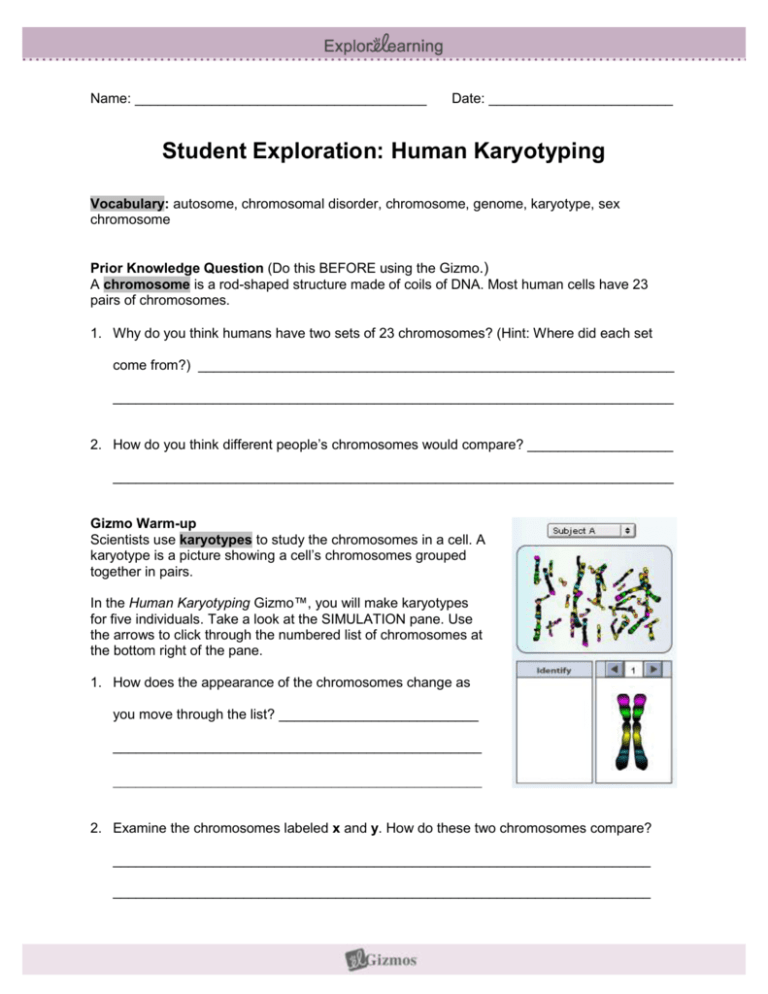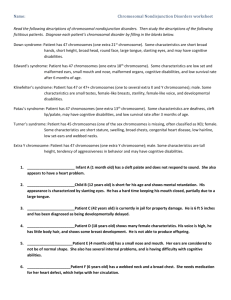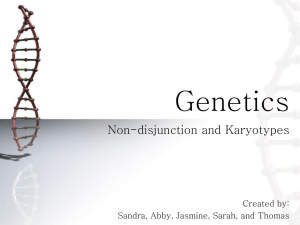Student Exploration Sheet: Growing Plants - Wood
advertisement

Name: ______________________________________ Date: ________________________ Student Exploration: Human Karyotyping Vocabulary: autosome, chromosomal disorder, chromosome, genome, karyotype, sex chromosome Prior Knowledge Question (Do this BEFORE using the Gizmo.) A chromosome is a rod-shaped structure made of coils of DNA. Most human cells have 23 pairs of chromosomes. 1. Why do you think humans have two sets of 23 chromosomes? (Hint: Where did each set come from?) ______________________________________________________________ _________________________________________________________________________ 2. How do you think different people’s chromosomes would compare? ___________________ _________________________________________________________________________ Gizmo Warm-up Scientists use karyotypes to study the chromosomes in a cell. A karyotype is a picture showing a cell’s chromosomes grouped together in pairs. In the Human Karyotyping Gizmo™, you will make karyotypes for five individuals. Take a look at the SIMULATION pane. Use the arrows to click through the numbered list of chromosomes at the bottom right of the pane. 1. How does the appearance of the chromosomes change as you move through the list? __________________________ ________________________________________________ _________________________________________________ 2. Examine the chromosomes labeled x and y. How do these two chromosomes compare? ______________________________________________________________________ ______________________________________________________________________ Activity A: Activity B: Male and female karyotypes Chromosomal disorders Get the Gizmo ready: Get the Gizmo ready: Click Reset. Click Reset. Question: How are male karyotypes different from female karyotypes? 1. Compare: In the SIMULATION pane, make sure Subject A is selected. Click on and drag one of subject A’s chromosomes to the area labeled Identify. Use the arrows to compare the chromosome you picked with chromosomes 1 through 22 and also with X and Y. Which chromosome did you select? ____________________________________________ 2. Create: Drag the chromosome to the appropriate position on the KARYOTYPING pane. Then select another chromosome, identify it, and place it on the karyotype. 3. Count: Chromosomes 1 through 22 are called autosomes. Examine the karyotype you have created. How many total autosomes do human cells have? __________________________ 4. Draw conclusions: Look at chromosome pair 23. These chromosomes are known as sex chromosomes because they determine the sex of an individual. Females have two copies of the X chromosome. Males have one X chromosome and one Y chromosome. Examine the karyotype. Is subject A a male or female? _____________________________ How do you know? _________________________________________________________ Click the DIAGNOSIS tab to check your answer. 5. Analyze: Select Subject B from the SIMULATION pane. Complete subject B’s karyotype. Take a snapshot of the completed karyotype, paste it into your document, and label it. Examine the karyotype. Is Subject B a male or female? _____________________________ How do you know? _________________________________________________________ Click the DIAGNOSIS tab to check your answer. 6. Think and discuss: On the SIMULATION pane, compare the X and Y chromosomes. Which chromosome do you think has more DNA? Explain. ________________________________ _________________________________________________________________________ Question: How can you use a karyotype to diagnose a disease? 1. Compare: Select Subject C from the SIMULATION pane. Identify each of subject C’s chromosomes, and place them on the KARYOTYPING pane. Once you have completed the karyotype, take a snapshot of it. Paste the snapshot into a document. Label it “Subject C.” How does subject C’s karyotype differ from a normal karyotype? _________________________________________________________________________ 2. Diagnose: A chromosomal disorder occurs when a person’s cells do not have the correct number of chromosomes. The table below lists three common chromosomal disorders. Disorder Description Down syndrome Extra chromosome 21 Klinefelter syndrome Extra X in male (XXY) Turner syndrome Single X in female (XO) Subject Symptoms Use the table to determine which disorder subject C has. Record your diagnosis in the third column of the table, and then click on the DIAGNOSIS tab to check your answer. Summarize the information on the DIAGNOSIS tab in the fourth column of the table. 3. Repeat: Complete the karyotypes for Subject D and Subject E. Determine which disorder each subject has, and use the information from the Gizmo’s DIAGNOSIS tab to complete the table. Be sure to keep snapshots of both karyotypes. (Activity B continued on next page) Activity B (continued from previous page) 4. Generalize: Another chromosomal disorder, called Edward’s syndrome, occurs when a person’s cells have three copies of chromosome 18. People who have Edward’s syndrome are severely mentally retarded and their skeletons are malformed. Most people with Edward’s syndrome die in infancy. Use the above information about Edward’s syndrome and the descriptions of Down syndrome, Klinefelter syndrome, and Turner syndrome in the table on the previous page to compare these four different chromosomal disorders. A. Which type of chromosomal disorders seems to have the greatest affect on a person’s health—disorders involving autosomes or sex chromosomes? ___________________________________________________________________ B. Why do you think this might be the case? __________________________________ ___________________________________________________________________ ___________________________________________________________________ ___________________________________________________________________ 5. Extend your thinking: Klinefelter syndrome only affects males, and Turner syndrome only affects females. Examine the karyotypes of the subjects you diagnosed with Klinefelter syndrome and Turner syndrome. A. How do you think sex is determined in a person with a chromosomal disorder involving the sex chromosomes? _________________________________________ ___________________________________________________________________ B. Individuals with a genetic disorder called trisomy X have three X chromosomes. (These individuals are normal and do not have any particular symptoms.) What sex would a person with trisomy X be? _______________________________ 6. Summarize: The genome of an organism is its total genetic material. What aspects of the genome can and cannot be determined through karyotyping? _________________________________________________________________________ _________________________________________________________________________ _________________________________________________________________________ _________________________________________________________________________









